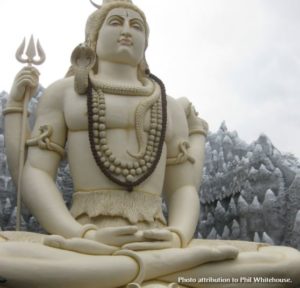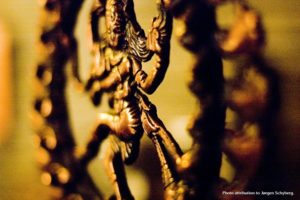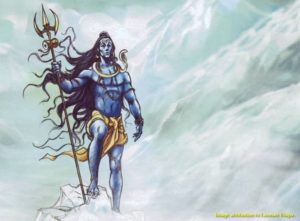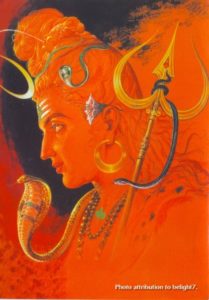Lord Shiva is the Sanatana Dharma (Hindu) deity of transformation and completion. The holiday of Shivaratri is dedicated to Lord Shiva. It is celebrated on the moonless night of the month of Phalguna. This is the fourteenth day in the krishnapaksha period. This also known as the dark half period. It is especially auspicious and helpful to do spiritual practices on this day because of a favorable alignment of the planets. In the Puranas (some of the sacred texts of Sanatana Dharma) there are references to this.  Shiva himself tells his consort Parvati Devi (the Divine Mother) that this day is particularly dear to him. He states that those who perform proper austerities (penences) on this day will be released from the bondage of their sins.
Shiva himself tells his consort Parvati Devi (the Divine Mother) that this day is particularly dear to him. He states that those who perform proper austerities (penences) on this day will be released from the bondage of their sins.
The Story of Suswara
Here is a popular story from the Puranas: Once there was a poor hunter who lived in Varanasi. His name was Suswara and he lived with his wife and one child in a small hut. They lived a poor, simple life with only minimal money and resources. To help feed his family, Suswara would go to the forest and hunt for wild game. One day he was blessed with fortune and caught many small animals and birds which he put into a sack. He was happy with catching so much food, so he wandered deeper into the forest in search of more game. But soon darkness set in and he decided to return home. Even though he was an experienced hunter, he was a little worried as the forest was infested with dangerous animals. He was nervous about the idea of spending the night there. But soon it became very dark and he was unable to find his way back. So Suswara climbed a tree to be safe from the wild animals. He settled into some branches to take rest.
Attracted by his scent, some wild animals came lurking under the tree. Suswara plucked some twigs from the tree and threw them at the animals, but to no avail. He could not scare them away. All through the night the animals kept prowling beneath the tree, looking for a way to catch the hunter!

With the animals prowling below, Suswara was unable to sleep even for a moment. Throughout the night, he was awake with his full attention on the animals. From the tree, he plucked leaves and dropped them on the ground. The tree happened to be a bilva tree (which is a tree dear to Lord Shiva). Unknown to Suswara, at the foot of the tree was a Shivalinga (a sacred object symbolizing Lord Shiva). Susware was not aware that by dropping the sacred bilva leaves, he was making a sacred offering to the Shivalinga. And it happened that this night was Shivaratri. So the hunter had unknowingly kept a vigil all night and worshipped Shiva.
The Shiva Purana is one of the sacred texts describing the life of Lord Shiva. According to this scripture, the Mahashivaratri worship should incorporate six items: giving the shiva lingam a ceremonial bath and then offering bilva leaves to the deity, which represents purification of the soul; applying vermilion paste on the linga after bathing it, which represents virtue; offering food, which is auspicious for longevity and the gratification of desires; lighting incense, which yields wealth; lighting an oil lamp, which symbolizes the attainment of knowledge; and, finally, offering betel leaves, which marks satisfaction with worldly pleasures. These six items form an indispensable part of the Mahashivaratri worship, be it a simple ceremony at home or grand temple worship.
Significance of the Rituals

The story above is an allegory. Just as the hunter seeks out and kills kill wild animals, so to the spiritual seeker works to overcome hatred, greed, lust, anger, infatuation and jealousy.
The jungle symbolizes the mind where all these negativities live and roam about. A spiritual aspirant must kill these “animals” of the ego to be truly free.
The hunter’s name was Suswara, which means “one of melodious and pleasing voice”. This indicates the purity of intent and speech of Suswara. This in turn, implies a level of mental purity and receptiveness to spiritual learning.
The hunter was born in the famous city Varanasi in northeastern India not far from the Himalayas. “Vara” refers to the forehead while “nasi” is the nose. The point where both meet is Varanasi, in other words, the point midway between the eyebrows. This point is also called the ajna chakra and is regarded as a nexus of the three nadis: ida, pingala and sushumna. (“Nadis” are the lines of subtle energy that run throughout the body.) A spiritual aspirant who focuses their mind on this point gains concentration and gradually achieves control over their senses. The killing of the animals by Suswara thus symbolizes control over one’s vasanas (latent tendencies).
 The spinal column is represented by the bilva tree. The leaves of the bilva tree are special: each stalk has three leaflets. The three leaflets represent the three nadis mentioned above. The climbing of the tree represents the ascent of the kundalini shakti (power) from the muladhara (lowest chakra at the base of the spine) to the ajna chakra (located between the eyebrows; also known as the “third eye”).
The spinal column is represented by the bilva tree. The leaves of the bilva tree are special: each stalk has three leaflets. The three leaflets represent the three nadis mentioned above. The climbing of the tree represents the ascent of the kundalini shakti (power) from the muladhara (lowest chakra at the base of the spine) to the ajna chakra (located between the eyebrows; also known as the “third eye”).
Staying awake is symbolic of the clear and unbroken awareness and clarity of purpose that a spiritual aspirant needs to reach the goal of spiritual awakening. He or she cannot afford to be slack even for a moment.
Lord Shiva is the Supreme Consciousness that illuminates and permeates the three states of waking, dreaming and deep sleep. Offering the threefold bilva leaves to the Shivalinga heralds the return to a level of consciousness beyond the three states, which is the fourth state, turiya (pure consciousness free from egoic bondage). The arising of that state of turiya goes with the awakening of the individual.
Author: Amrita Yoga
(As always, thoughtful comments are invited and appreciated. Share your reflections with us! See below to leave a comment.)

0 Comments